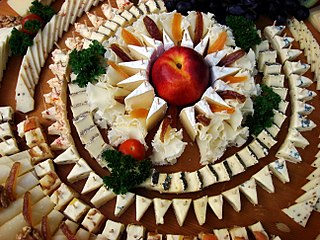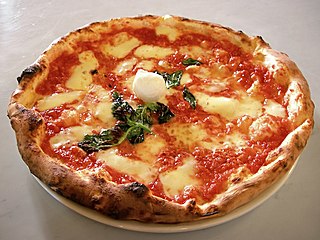
A Chianti wine is any wine produced in the Chianti region of central Tuscany. It was historically associated with a squat bottle enclosed in a straw basket, called a fiasco. However, the fiasco is only used by a few makers of the wine as most Chianti is now bottled in more standard shaped wine bottles. In the mid-late 19th century, Baron Bettino Ricasoli helped establish Sangiovese as the blend's dominant grape variety, creating the blueprint for today's Chianti wines.

Pecorino Romano is a hard, salty Italian cheese, often used for grating, made with sheep's milk. The name "pecorino" simply means "ovine" or "of sheep" in Italian; the name of the cheese, although protected, is a simple description rather than a brand: "[formaggio] pecorino romano" is simply "sheep's [cheese] of Rome".

Parmesan is an Italian hard, granular cheese produced from cows' milk and aged at least 12 months.

Gorgonzola is a veined PDO Italian blue cheese, made from unskimmed cow's milk. It can be buttery or firm, crumbly and quite salty, with a "bite" from its blue veining. Outside the EU and the countries recognizing the geographical origin protection, the name "Gorgonzola" can legally be used for similar cheeses, with only the full Italian name unambiguously referring to PDO Gorgonzola. It is a famously pungent cheese.

Goat cheese, goat's cheese, or chèvre, is cheese made from goat's milk. Goats were among the first animals to be domesticated for producing food. Goat cheese is made around the world with a variety of recipes, giving many different styles of cheese, from fresh and soft to aged and hard.

Asiago is a cow's milk cheese, first produced in the homonymous town in Italy, that can assume different textures according to its aging, from smooth for the fresh Asiago to a crumbly texture for the aged cheese. The aged cheese is often grated in salads, soups, pastas, and sauces while the fresh Asiago is sliced to prepare panini or sandwiches; it can also be melted on a variety of dishes and cantaloupe. It is classified as a Swiss-type or Alpine cheese.

Balsamic vinegar is a dark, concentrated, intensely flavoured vinegar originating in Modena, Italy, made wholly or partially from grape must: freshly crushed grape juice with all the skins, seeds and stems.

Buffalo mozzarella is a mozzarella made from the milk of Italian Mediterranean buffalo. It is a dairy product traditionally manufactured in Campania, especially in the provinces of Caserta and Salerno.

Fontina is a cow's milk cheese, first produced in Italy. Over time, production of Fontina has spread worldwide, including to the United States, Denmark, Sweden, Canada, France and Argentina.

Pecorino sardo is a firm cheese from the Italian island of Sardinia which is made from sheep milk: specifically from the milk of the local Sardinian breed. It was awarded Denominazione d'Origine status in 1991 and granted Protected designation of origin protection in 1996, the year in which this European Union certification scheme was introduced.

Monte Veronese is an Italian cheese made from cow's milk which is produced in the northern part of the Province of Verona, more specifically in the Lessini mountains or the Veronese prealps. Like Asiago it comes in two varieties, one fresh and one matured.

Cheese is a dairy product produced in wide ranges of flavors, textures, and forms by coagulation of the milk protein casein. It comprises proteins and fat from milk. During production, milk is usually acidified and either the enzymes of rennet or bacterial enzymes with similar activity are added to cause the casein to coagulate. The solid curds are then separated from the liquid whey and pressed into finished cheese. Some cheeses have aromatic molds on the rind, the outer layer, or throughout.

There are many different types of cheese. Cheeses can be grouped or classified according to criteria such as length of fermentation, texture, methods of production, fat content, animal milk, and country or region of origin. The method most commonly and traditionally used is based on moisture content, which is then further narrowed down by fat content and curing or ripening methods. The criteria may either be used singly or in combination, with no single method being universally used.

Neapolitan pizza, also known as Naples-style pizza, is a style of pizza made with tomatoes and mozzarella cheese. The tomatoes must be either San Marzano tomatoes or Pomodorino del Piennolo del Vesuvio, which grow on the volcanic plains to the south of Mount Vesuvius. The cheese must be Mozzarella di Bufala Campana, a protected designation of origin cheese made with the milk from water buffalo raised in the marshlands of Campania and Lazio in a semi-wild state, or Fior di Latte, a cow's milk mozzarella created according to the procedure for which it was registered as a Traditional Speciality Guaranteed (TSG). Pizza Napoletana is a Traditional Speciality Guaranteed (TSG) product in the European Union and the United Kingdom, and the art of its making is included on UNESCO's list of intangible cultural heritage.

Kanterkaas is a Dutch yellow cheese made from cow's milk. Apart from the plain variety, there is Kanterkomijnekaas which is flavored with cumin and Kanternagelkaas flavored with both cumin and cloves. Kanter is Dutch for 'edge' and refers to the sharp angle at the point where the side of the cheese wheel meets the base. It was granted a Protected Designation of Origin by the European Union in 2000 and may only be produced in the province of Friesland and the Westerkwartier area. The unprotected name Frisian clove cheese is commonly used for other Dutch cheeses which are similar to Kanternagelkaas.
Silter is an Italian hard cheese made within the Alpine Lombardy region around Province of Brescia and surrounding areas and traditionally produced with unpasteurised cows milk during summer months and September, is brined, and aged for a minimum of 6 months.
Pecorino di Carmasciano, or simply Carmasciano, is an Italian cheese of the Pecorino family of cheeses made from sheep's milk. It has been recognized since 2009 by the Italian Ministry of Agricultural, Food and Forestry Policies as a prodotto agroalimentare tradizionale, abbreviated as PAT. Pecorino di Carmasciano was featured at Expo 2015 in Milan.

Puzzone di Moena, is an Italian PDO cheese, with a washed rind, fat and semi-hard pressed paste made from raw cow's milk.

















